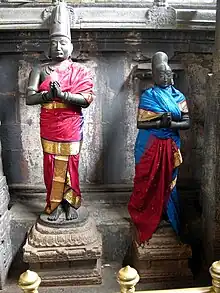Achyuta Deva Raya
Achyuta Deva Raya (r. 1529 - 1542 CE) was an Emperor of Vijayanagara who succeeded his older brother, the Emperor Krishna Deva Raya after the latter's death in 1529 CE.
| Achyuta Deva Raya | |
|---|---|
| Emperor | |
 Statues depicting Achyuta Deva Raya (left) and his Queen (right) | |
| Emperor of Vijayanagara | |
| Reign | 1529 – 1542 CE |
| Predecessor | Krishna Deva Raya |
| Successor | Venkata I |
| Spouse | Varadarajamma |
| Issue | Venkata I |
| Dynasty | Tuluva |
| Father | Tuluva Narasa Nayaka |
| Mother | Obamamba[1] |
| Religion | Hinduism |
_at_Timmalapura.jpg.webp)

| Vijayanagara Empire |
|---|
| Ruling dynasties |
During his reign, Fernao Nuniz, a Portuguese-Jewish traveller, chronicler and horse trader visited India and spent three years in Vijayanagara.
Achyutaraya patronised the Kannada poet Chatu Vittalanatha, the great composer and singer Purandaradasa (The Father of Carnatic music), and the Sanskrit scholar Rajanatha Dindima II. Upon his death, the succession was disputed. His son Venkata I succeeded him but ruled for a very short period and was killed in a chaotic succession dispute in which many claimants to the throne were killed. The dispute ended when his nephew, (younger brother's son) Sadasiva Raya, finally became the Emperor while yet a child, under the regency of Rama Raya, a son-in-law of Krishnadevaraya. His wife's name was probably Vasudha Devi. Sadasiva Raya was probably the son of Vasudha Devi's sister Hemavati and her husband Ranga Raya.

Reign
_at_Vitthala_temple_in_Hampi.JPG.webp)
_of_Achyuta_Raya_at_entrance_to_Vitthala_temple_in_Hampi.JPG.webp)

The time when Achyuta Deva Raya became the Emperor was by no means a favorable one. The peace and prosperity of the halcyon days under Krishna Deva Raya were coming to an end. Feudatories and enemies were waiting for an opportunity to bring down the empire. In addition, Achyuta Deva Raya had to contend with the powerful Rama Raya, who was competing for the throne.
While the works of Nuniz speak very lowly of Achyuta Deva Raya as being a Monarch given to vices and cruelty, there is enough evidence to prove that the Emperor was indeed noteworthy in his own right and fought hard to keep the prosperity of the Empire alive. He had been personally chosen by Krishna Deva Raya himself as a capable successor, handpicked to assume the imperial throne.
The Turko-Persian Sultan Ismail Adil Shah of Bijapur invaded and captured the Raichur doab. However the Gajapatis of Orissa and Quli Qutub Shah of Golconda Sultanate were defeated and pushed back. Now Achyuta Deva Raya along with his general Salakaraju Tirumala went on a southern campaign to bring the governors of Travancore and Ummathur under control. This they did successfully. Then they attacked the doab north of the Tungabhadra and recaptured the forts of Raichur and Mudgal successfully.
The two Sanskrit works Achyutabhyudayam and Varadambikaparinayam describe the Emperor's life and rule in detail.
Throughout his rule, Achyuta Deva Raya had to contend with the manipulations of Rama Raya who in his powerful capacity had replaced many of the faithful servants of the Empire in high ranking positions with men of his own favour. On more than one occasion the Bahmani Sultans were brought in to play the role of mediator between the Emperor and Aliya Rama Raya in the game of power sharing. This would further weaken the Empire. Around 1540 CE, Rama Raya imprisoned Achyuta Deva Raya in a coup.
In 1542 CE, Achyuta Deva Raya died, and was succeeded by his young son of Venkata I (Venkata Raya or Venkatadri Raya). But he was soon killed, and Sadasiva Raya became the new Emperor. Rama Raya became the imperial regent and let very little governance in the hands of Sadasiva Raya.
The Tiruvengalanatha temple was built at Vijayanagara during his reign. It has become popularly known by his name as Achyutaraya temple, rather than by the name of the deity Lord Venkateshwara to whom the temple was dedicated.
References
- Ayyangar, Krishnaswamy (1919). Sources of Vijayanagar History. Chennai: University of Madras. p. 16.
- Prof K.A. Nilakanta Sastri, History of South India, From Prehistoric times to fall of Vijayanagar, 1955, OUP, New Delhi (Reprinted 2002)